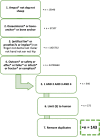The safety of one-stage versus two-stage approach to osseointegrated prosthesis for limb amputation
- PMID: 37475711
- PMCID: PMC10359829
- DOI: 10.1302/2633-1462.47.BJO-2022-0117.R1
The safety of one-stage versus two-stage approach to osseointegrated prosthesis for limb amputation
Abstract
Aims: Safety concerns surrounding osseointegration are a significant barrier to replacing socket prosthesis as the standard of care following limb amputation. While implanted osseointegrated prostheses traditionally occur in two stages, a one-stage approach has emerged. Currently, there is no existing comparison of the outcomes of these different approaches. To address safety concerns, this study sought to determine whether a one-stage osseointegration procedure is associated with fewer adverse events than the two-staged approach.
Methods: A comprehensive electronic search and quantitative data analysis from eligible studies were performed. Inclusion criteria were adults with a limb amputation managed with a one- or two-stage osseointegration procedure with follow-up reporting of complications.
Results: A total of 19 studies were included: four one-stage, 14 two-stage, and one article with both one- and two-stage groups. Superficial infection was the most common complication (one-stage: 38% vs two-stage: 52%). There was a notable difference in the incidence of osteomyelitis (one-stage: nil vs two-stage: 10%) and implant failure (one-stage: 1% vs two-stage: 9%). Fracture incidence was equivocal (one-stage: 13% vs two-stage: 12%), and comparison of soft-tissue, stoma, and mechanical related complications was not possible.
Conclusion: This review suggests that the one-stage approach is favourable compared to the two-stage, because the incidence of complications was slightly lower in the one-stage cohort, with a pertinent difference in the incidence of osteomyelitis and implant failure.
© 2023 Author(s) et al.
Conflict of interest statement
M. Al Muderis reports royalties from and shares in Osseointegration International Pty Ltd, unrelated to this study. W. Lu is employed by Osseointegration International Pty Ltd.
Figures





Similar articles
-
Osseointegrated Prosthetic Implants for People With Lower-Limb Amputation: A Health Technology Assessment.Ont Health Technol Assess Ser. 2019 Dec 12;19(7):1-126. eCollection 2019. Ont Health Technol Assess Ser. 2019. PMID: 31911825 Free PMC article.
-
Have Surgery and Implant Modifications Been Associated With Reduction in Soft Tissue Complications in Transfemoral Bone-anchored Prostheses?Clin Orthop Relat Res. 2023 Jul 1;481(7):1373-1384. doi: 10.1097/CORR.0000000000002535. Epub 2023 Jan 6. Clin Orthop Relat Res. 2023. PMID: 36607733 Free PMC article.
-
Revision Amputation with Press-Fit Osseointegration for Transfemoral Amputees.JBJS Essent Surg Tech. 2022 Jun 1;12(2):e21.00068. doi: 10.2106/JBJS.ST.21.00068. eCollection 2022 Apr-Jun. JBJS Essent Surg Tech. 2022. PMID: 36741033 Free PMC article.
-
Systematic review of the safety and efficacy of osseointegration prosthesis after limb amputation.Br J Surg. 2018 Dec;105(13):1731-1741. doi: 10.1002/bjs.11005. Epub 2018 Oct 11. Br J Surg. 2018. PMID: 30307036
-
Osseointegrated Prosthetic Limb for the treatment of lower limb amputations : Experience and outcomes.Unfallchirurg. 2017 Apr;120(4):306-311. doi: 10.1007/s00113-016-0296-8. Unfallchirurg. 2017. PMID: 28070628 Review. English.
Cited by
-
The osteoinductive and osseointegration properties of decellularized extracellular matrix bone derived from different sites.Bone Joint Res. 2025 Apr 3;14(4):292-308. doi: 10.1302/2046-3758.144.BJR-2024-0080.R3. Bone Joint Res. 2025. PMID: 40176776 Free PMC article.
-
Single-Stage Press-Fit Osseointegration of the Radius and Ulna for Rehabilitation After Trans-Forearm Amputation.JBJS Essent Surg Tech. 2024 Jul 10;14(3):e23.00015. doi: 10.2106/JBJS.ST.23.00015. eCollection 2024 Jul-Sep. JBJS Essent Surg Tech. 2024. PMID: 38988477 Free PMC article.
-
Complications Following Osseointegrated Transfemoral and Transtibial Implants: A Systematic Review.Cureus. 2024 Mar 27;16(3):e57045. doi: 10.7759/cureus.57045. eCollection 2024 Mar. Cureus. 2024. PMID: 38681289 Free PMC article. Review.
-
Self-reported health outcomes and medical complications at 6- and 8-year follow-up after direct skeletal fixation in individuals with bilateral transfemoral amputations.Int J Rehabil Res. 2025 Sep 1;48(3):173-179. doi: 10.1097/MRR.0000000000000677. Epub 2025 Jul 11. Int J Rehabil Res. 2025. PMID: 40637205 Free PMC article.
-
Bone-anchored prostheses for transfemoral amputation: a systematic review of outcomes, complications, patient experiences, and cost-effectiveness.Front Rehabil Sci. 2024 Apr 2;5:1336042. doi: 10.3389/fresc.2024.1336042. eCollection 2024. Front Rehabil Sci. 2024. PMID: 38628292 Free PMC article.
References
-
- Brånemark RP, Hagberg K, Kulbacka-Ortiz K, Berlin Ö, Rydevik B. Osseointegrated percutaneous prosthetic system for the treatment of patients with transfemoral amputation: A prospective five-year follow-up of patient-reported outcomes and complications. J Am Acad Orthop Surg. 2019;27(16):e743–e751. doi: 10.5435/JAAOS-D-17-00621. - DOI - PMC - PubMed

